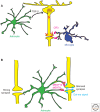Astrocytes Control Synapse Formation, Function, and Elimination
- PMID: 25663667
- PMCID: PMC4527946
- DOI: 10.1101/cshperspect.a020370
Astrocytes Control Synapse Formation, Function, and Elimination
Abstract
Astrocytes, through their close associations with synapses, can monitor and alter synaptic function, thus actively controlling synaptic transmission in the adult brain. Besides their important role at adult synapses, in the last three decades a number of critical findings have highlighted the importance of astrocytes in the establishment of synaptic connectivity in the developing brain. In this article, we will review the key findings on astrocytic control of synapse formation, function, and elimination. First, we will summarize our current structural and functional understanding of astrocytes at the synapse. Then, we will discuss the cellular and molecular mechanisms through which developing and mature astrocytes instruct the formation, maturation, and refinement of synapses. Our aim is to provide an overview of astrocytes as important players in the establishment of a functional nervous system.
Copyright © 2015 Cold Spring Harbor Laboratory Press; all rights reserved.
Figures




References
-
- Albrecht D, Lopez-Murcia FJ, Perez-Gonzalez AP, Lichtner G, Solsona C, Llobet A. 2012. SPARC prevents maturation of cholinergic presynaptic terminals. Mol Cell Neurosci 49: 364–374. - PubMed
-
- Araque A, Parpura V, Sanzgiri RP, Haydon PG. 1999. Tripartite synapses: Glia, the unacknowledged partner. Trends Neurosci 22: 208–215. - PubMed
Publication types
MeSH terms
Grants and funding
LinkOut - more resources
Full Text Sources
Other Literature Sources
